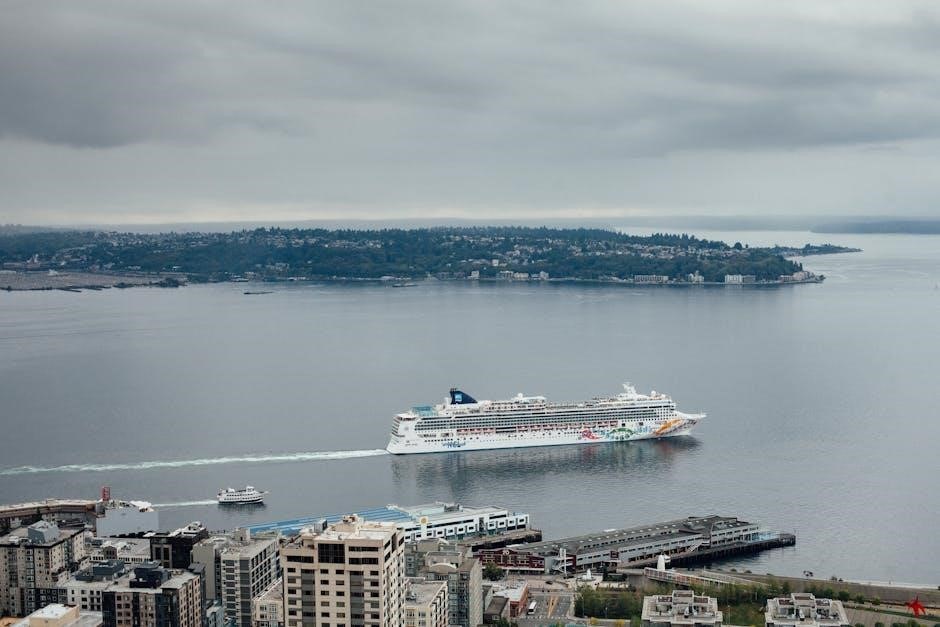Overview of the Port of Tyne
The Port of Tyne, located near Newcastle, is a significant deep-sea port handling diverse cargoes and vessels, including cruise ships, cargo ships, and passenger ferries, supporting regional trade and tourism.
1.1 Location and Significance
The Port of Tyne is strategically located near Newcastle in North Shields, England, serving as a gateway to the North Sea. Its deep-sea capabilities make it a vital hub for trade and tourism, connecting the region to global markets. The port’s proximity to Newcastle enhances its economic significance, supporting cargo operations and passenger services while fostering regional growth and development.
1.2 Types of Cargo and Vessels Handled
The Port of Tyne manages a diverse range of cargo, including bulk goods, containers, and project cargo, catering to international trade. It accommodates various vessel types, such as bulk carriers, container ships, and cruise liners. The port’s advanced facilities ensure efficient handling of cargo, supporting both regional and global trade while maintaining its reputation as a key maritime hub in the UK.
Real-Time Departures from the Port of Tyne
Stay updated on vessel movements with real-time departure tracking via tools like MarineTraffic. Get current schedules and monitor ship activity efficiently using the port’s official resources.
2.1 Current Departure Schedule
The Port of Tyne’s current departure schedule provides real-time updates on vessel movements, including expected departure times and ship details. Accessible via MarineTraffic or the port’s official website, this data helps track cargo ships, cruise liners, and ferries as they prepare to depart. Regular updates ensure accuracy, making it a reliable resource for planning and monitoring maritime activities efficiently;
2.2 How to Track Vessel Movements
To track vessel movements at the Port of Tyne, utilize real-time tools like MarineTraffic or the port’s official website. Enter the vessel name, IMO number, or use the interactive map to monitor departures. Updates are provided regularly, ensuring accurate and timely information for efficient tracking of ships, cargo vessels, and ferries.

Interactive Map of the Port of Tyne
The interactive map provides real-time tracking of vessel movements, port facilities, and departure routes. Users can zoom in to view detailed information about ships and dock locations.
3.1 Features of the Interactive Map
The interactive map offers real-time vessel tracking, detailed port facilities, and zoom capabilities. It displays current departures, ship locations, and weather conditions. Users can view berth allocations, navigation channels, and key landmarks. The map also provides route planning tools and historical vessel movement data, enhancing navigation and operational efficiency for both passengers and cargo operators.
3.2 How to Use the Map for Departures
Access the interactive map via the Port of Tyne’s official website or MarineTraffic. Use the real-time tracking feature to monitor vessel movements. Filter by departure times, ship types, or destinations. Zoom in to view berth allocations and navigate through the timeline for past or future departures. The map also links to PDF guides for detailed schedules and terminal layouts.

PDF Guides for Port of Tyne Departures
PDF guides provide detailed schedules, terminal layouts, and departure information. Download the latest versions from the Port of Tyne’s official website for convenient planning.
4.1 Importance of PDF Guides
PDF guides are essential for planning and navigating Port of Tyne departures. They provide detailed schedules, terminal layouts, and real-time updates, ensuring passengers and logistics teams stay informed. These guides reduce confusion and enhance efficiency, offering a reliable resource for seamless travel and cargo management. They are accessible on the Port of Tyne’s official website and platforms like MarineTraffic for convenient downloading.
4.2 Where to Download the Latest PDF Maps
The latest PDF maps for Port of Tyne departures are available on the official Port of Tyne website and platforms like MarineTraffic. Users can also access these resources through the My Ambassador Sailing page or the Ambassador App. These platforms provide up-to-date schedules, terminal layouts, and real-time updates, ensuring easy access to essential information for planning and navigation.

Vessel Tracking Systems
Vessel tracking systems like AIS and MarineTraffic provide real-time monitoring of ship movements, enabling users to track departures and arrivals at the Port of Tyne efficiently.
5.1 AIS (Automatic Identification System)
The Automatic Identification System (AIS) is a maritime navigation system that provides real-time vessel tracking. It uses VHF radio communication to exchange ship data, such as position, speed, and heading. AIS enhances safety, collision avoidance, and traffic management. The Port of Tyne utilizes AIS to monitor vessel movements, ensuring efficient and safe operations for all ships, including cargo vessels, ferries, and cruise liners.
5.2 MarineTraffic and Other Tracking Tools
MarineTraffic is a leading platform for real-time vessel tracking, offering detailed insights into ship movements at the Port of Tyne. It complements AIS data, providing updates on arrivals, departures, and weather conditions. Additionally, interactive maps and downloadable PDF guides are available, enhancing tracking capabilities. These tools collectively ensure efficient monitoring and planning for all port activities.
Weather Forecast for the Port of Tyne
The Port of Tyne’s weather forecast provides real-time updates, including wind conditions and tidal changes, ensuring safe vessel operations and informed departure planning for all port activities.
6.1 Current Weather Conditions
The Port of Tyne experiences variable weather, with real-time updates offering insights into wind speed, tidal levels, and visibility. Current conditions are crucial for ensuring safe vessel operations and departure planning, as adverse weather can impact navigation and scheduling. The port’s weather monitoring systems provide accurate data to support maritime activities and maintain operational efficiency.
Weather conditions significantly influence Port of Tyne departures, with wind, fog, and storms potentially delaying operations. Adverse weather can impact visibility, vessel stability, and navigation, requiring careful planning and safety measures. The port monitors weather forecasts to adjust schedules, ensuring safe departures and minimizing disruptions to cargo and passenger services.
Cruise Ship Departures from the Port of Tyne
6.2 Impact of Weather on Departures
Weather conditions like strong winds and fog can delay departures, affecting visibility and navigation. The port adjusts schedules to ensure safety, minimizing disruptions to cargo and passenger services.
7.1 Popular Cruise Routes
The Port of Tyne offers scenic cruise routes, including round-trip journeys to Scandinavia, exploring Norway’s fjords, and visits to Baltic ports like Amsterdam and Copenhagen. The Spirit of Adventure frequently departs on 14-day itineraries, combining cultural experiences with breathtaking natural beauty, attracting travelers seeking both exploration and relaxation.
7.2 Schedule for Upcoming Cruises
Upcoming cruises from the Port of Tyne include the Spirit of Adventure’s 14-day round-trip journey starting May 9, 2025. The itinerary features visits to Scandinavian ports and Baltic destinations, offering a mix of cultural and natural experiences. Schedules are available on the My Ambassador Sailing page or through the Ambassador App for detailed planning and real-time updates.
Cargo Ship Departures
The Port of Tyne efficiently handles cargo ships transporting containers, bulk goods, and project cargo, with frequent daily and weekly departures supporting regional and international trade logistics.
8.1 Types of Cargo Transported
The Port of Tyne handles a diverse range of cargo, including containers, bulk goods like coal and aggregates, project cargo, and specialized freight. Its deep-sea capabilities enable efficient transportation of goods across international trade routes, supporting industries such as construction, energy, and manufacturing. The port’s versatile facilities ensure secure and efficient loading and unloading of various cargo types, catering to global trade demands.
8.2 Frequency of Cargo Ship Departures
Cargo ships depart from the Port of Tyne regularly, with schedules adjusting to tidal conditions and global trade demands. The port typically sees multiple weekly departures, accommodating both regional and international routes. Efficient handling ensures timely arrivals and departures, maintaining a reliable service for cargo operations connecting the UK to worldwide markets seamlessly.

Passenger Ferry Departures
Passenger ferries operate regularly from the Port of Tyne, offering routes to popular destinations. Services run daily, connecting passengers to key regional and international locations efficiently.
9.1 Routes and Destinations
Passenger ferries from the Port of Tyne serve diverse routes, connecting to nearby coastal towns, regional hubs, and international destinations. Key destinations include Amsterdam, northern European ports, and scenic coastal stops, catering to both commuters and tourists. The ferry services ensure efficient and scenic travel, linking Tyne to vital maritime networks across the North Sea and beyond.
9.2 Timetable for Ferry Services
The Port of Tyne’s ferry timetable offers frequent and reliable services, with multiple daily departures catering to both commuters and tourists. Schedules are available in real-time via the port’s website or downloadable PDF guides, ensuring passengers can plan their journeys efficiently. Regular updates and seasonal adjustments are made to accommodate demand, providing a seamless travel experience.
Port of Tyne Terminal Facilities
The Port of Tyne features modern terminal facilities, including the International Passenger Terminal and advanced cargo handling infrastructure, ensuring efficient operations for both passengers and freight.
10.1 International Passenger Terminal
The International Passenger Terminal at the Port of Tyne is a state-of-the-art facility designed to accommodate cruise ships and ferries, offering modern amenities such as check-in areas, lounges, and secure parking. It also provides easy access to real-time departure information and interactive maps, enhancing the overall passenger experience for travelers embarking on journeys from this bustling port.
10.2 Facilities for Cargo Handling
The Port of Tyne is equipped with advanced cargo handling facilities, including specialized terminals for containers, bulk goods, and project cargo. These facilities are supported by modern cranes, storage areas, and efficient handling systems, ensuring quick and secure processing of goods. The port’s infrastructure is designed to manage a wide range of cargo types, catering to regional and international trade demands effectively.
Navigation and Safety Measures
The Port of Tyne employs advanced navigational aids, including AIS and real-time tracking systems, ensuring safe vessel movements. Stringent safety protocols, regular drills, and compliance with international maritime standards are prioritized to safeguard operations and personnel.
11.1 Navigational Aids in the Port
The Port of Tyne utilizes advanced navigational aids, including AIS (Automatic Identification System) and real-time vessel tracking tools like MarineTraffic. These systems enhance situational awareness, ensuring safe and efficient vessel movements. Additional aids such as electronic charts, radar, and GPS further support accurate navigation, minimizing risks and optimizing traffic flow within the port.
11.2 Safety Protocols for Vessel Departures
The Port of Tyne adheres to strict safety protocols for vessel departures, ensuring compliance with international maritime standards. Advanced systems like AIS (Automatic Identification System) and real-time tracking tools monitor movements. Weather conditions and traffic are closely assessed to prevent collisions. Regular safety drills and adherence to navigational aids guarantee secure and efficient departures, minimizing risks for all vessels operating in the port area.
Environmental Considerations
The Port of Tyne prioritizes sustainability, implementing initiatives to reduce emissions and minimize waste, ensuring environmental protection while efficiently managing departures and operations.
12.1 Sustainability Initiatives
The Port of Tyne actively implements sustainability initiatives, including reducing carbon emissions, utilizing renewable energy sources, and promoting eco-friendly practices to minimize environmental impact while maintaining efficient operations and departures.
12.2 Impact of Departures on the Environment
Port of Tyne departures contribute to environmental impacts such as emissions, noise pollution, and potential marine habitat disruptions. However, the port implements measures like stricter emission controls and waste management to mitigate these effects, ensuring sustainable practices align with operational efficiency and environmental preservation.
Additional Resources
Visit the official Port of Tyne website for detailed guides, maps, and real-time tracking tools. Explore MarineTraffic for vessel movements and download PDF resources for planning.
13.1 Official Port of Tyne Website
The official Port of Tyne website is the primary source for comprehensive information on departures, including real-time updates, downloadable PDF guides, and interactive maps. It also provides detailed schedules, vessel tracking tools, and contact information for inquiries. Visitors can access resources like cruise itineraries, cargo ship timetables, and ferry departure details, making it an essential platform for planning and staying informed.
13.2 Contact Information for Inquiries
For inquiries about departures, maps, or PDF guides, contact the Port of Tyne directly via phone, email, or postal address. Visit their official website for detailed contact options, including a contact form. The port’s team is available to assist with scheduling, terminal facilities, and general information, ensuring efficient support for all queries related to port operations and services.